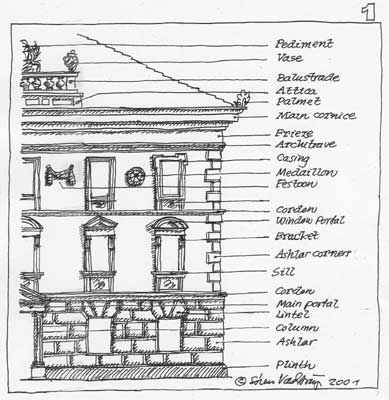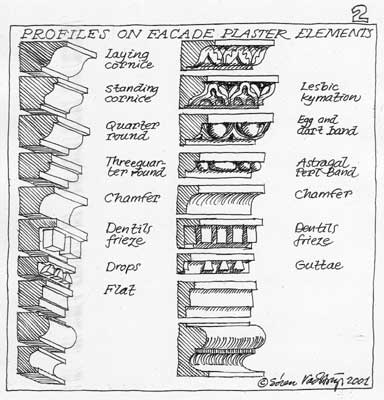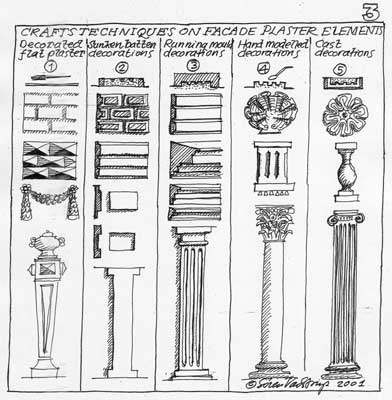Working
Techniques and Repair Methods for Plaster Decorations on Facades
By: Søren Vadstrup
1. Plaster decorations
on facades in lime-, gypsum- and cement-mortar
Introduction
As part of a European research-project
on Plaster Architecture in Europe from the XIX and XX Century, the
RAADVAD-Centre for Restoration and Traditional Crafts in Denmark has been
studying Working Techniques and Repair Methods for Plaster Decorations
on Facades.
The RAADVAD-CENTRE is the
national Danish research- and Information Centre for Restoration and Crafts.
The Centre is specialized in the restoration of buildings with traditional
crafts, traditional materials and traditional constructions. The activities
of the Centre are: Research, information, education and training courses,
consul-tants work and practical restoration work.
The Raadvad-Centre has 5 superior
aims:
1 To promote the preservation of
the Danish architectural heritage, including its character, its authenticity
end its appropriate use.
2 To promote the maintenance
of the building crafts, connected to the Danish architectural heritage,
including a number of small firms where only a few craftsmen are executing
their profession.
3 To promote the continuous
production and use of a number of traditional materials and craft skills
as they form part of old buildings.
4 To promote the most appropriate
economical methods of maintenance and restoration of old buildings.
5 To promote and develop the manufacture
and applications of the most sustainable materials, constructions and methods
within the building sector.
The research carried out for this
project has implied analysis of written sources, gathering of practice
experiences from concrete restoration works on plaster decorations on facades,
technical experiments with materials and methods, tools and utensils.
The working descriptions aim to
be a practical tool for concrete restoration- and renewal work on plaster
architecture all over Europe.
The author, architect Soeren Vadstrup,
Head of the Raadvad-Centre has been in charge of the research project,
and has for this purpose worked closely together with crafts firms, restoration
architects, other researchers and historians.
The material are also available at
the digital Crafts- and Restoration Database belonging to the Raadvad-Centre
on www.raadvad.dk - both in the English
and Danish version.
Typical elements of plaster decorations
on facades

In the XIX and XX Century, it was
very common to set up plaster decorations on building facades. The plaster
decorations might look exactly like decorations in natural stones, but
was much cheaper to produce. The primary purpose and effect of the plaster
decorations is therefore to imitate and look like natural stone decorations.
Drawing no. 1 shows some of these typical elements: Pediments, vases, balustrades,
main cornices, friezes, casings, festons, ashlar and stucco decorations.
Later on, from about 1870, the facades
became more and more decorated and overelaborated, which lead to the original,
innovative and vigorous Art Nouveau Style about 1900 - 1916. Also
the successors of this style, Art Deco and Functionalism imply facades
with more limited plaster decorations.
Typical mould elements

The plaster decorations very often
have their ideal from antique Greek and Roman temples and architecture.
Therefore they imply a number of typical mould elements from these models,
elements which also are repeated in joinery, masonry, wood- and stone carving
as well as interior stucco work.
The mould elements have both a simple
and a more detailed shaping. The names for the elements on the antique
Greek temples are often used for these common facade details.
Working techniques

In the authentic plaster works on
facades it is possible to distinguish between 5 various working techniques,
which are further described in the next chapters.
1. Ornamented flat plaster on facades
2. Sunken batten decorations in
plaster on facades
3. Running mould decorations in
plaster on facades
4. In-situ modelled decorations
in plaster on facades
5. Cast decorations in plaster,
gypsum or cement on facades
These working methods have their
own special elements and characteristics, but in certain cases the
various techniques may produce the same element, for instance a half column.
Index
|

